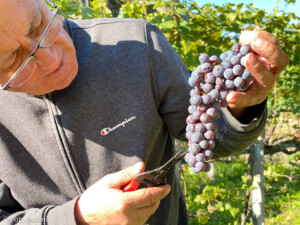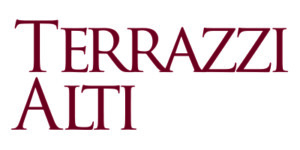Terrazzi Alti

Siro Buzzetti
About
Owner & winemaker: Siro Buzzetti
Vineyards: 1.5ha across five different parcels
Vineyard management: Practicing organic, worked entirely by hand
Soils: Sandy and silty glacial soils over gneiss bedrock
Grapes grown: Chiavennasca, Pignola, Rossola
Annual production: 4,000 bottles
Quick facts:
- “Terrazzi Alti” translates to “high terraces”–an apt name, as the grapes are grown on terraces between 420-600m above sea level.
- “Chiavennasca,” also called “Ciuvinasca,” is the local name for Nebbiolo: the name comes from the local dialect meaning “the most vinous” or “the best wine.”
- It’s hard to capture the breathtaking majesty of the terraced mountain vineyard sites in words or photos, but this video of Siro from 2021 is a good start.
Siro Buzzetti is not a winemaker by trade: he spent his career as a civil servant. He describes founding Terrazzi Alti in 2005 as a “journey of discovery”–he started in a tiny cellar where his grandfather used to store motorcycles, with little to no farming or winemaking experience. Despite having lived his whole life in Valtellina, he’d never worked in the vineyards before but was able to learn alongside a number of other new producers getting started at the same time. Since retiring from his public administration job, Siro has devoted himself to the vineyards full-time and has not slowed down in the slightest–he bounds effortlessly up and down the steep terraces on a daily basis, tending attentively to his vines. He was recently joined by his youngest son Francesco who now works alongside him in the vineyards.
The vineyards of Valtellina are a UNESCO world heritage site: the forbiddingly steep hillsides were converted into productive vineyard sites thanks to miles of dry stone terraces built primarily between the years 1000-1700. It’s hard to imagine a more idyllic place to make wine: the south-facing slopes benefit from plentiful sunlight; the altitude results in major diurnal shifts which help slow ripening so the grapes retain acidity and aromas; and the temperatures are moderated by the river flowing through the valley and near-constant breezes.
Viticulture here is done entirely by hand–frankly, there’s no way to get a tractor onto these precarious terraces if you wanted to. The vineyards are certified organic, with low amounts of copper and sulfur the only treatments used. The native grasses growing between the rows are periodically mowed by hand with a sickle. Siro and Francesco estimate that it takes about 1,500-1,700 man hours per hectare per year to farm these vines, work that is done primarily by the two of them. Since many people are unable or unwilling to do the hard manual work required to maintain vineyards on these terraces, Siro has been able to take over a few more small parcels from his elderly neighbors over the years. Having recently added a 0.2ha parcel of old vines to bring their total vineyard area to 1.5ha, he and Francesco are about at the limit of what the two of them can farm by hand.
Winemaking is kept simple: the grapes are picked by hand and carried to the winery in small baskets, where they are destemmed and gently crushed right away. Fermentation takes place spontaneously in stainless steel tanks, and after malolactic fermentation is complete, the wine is racked into untoasted used French oak barrels to age for a minimum of twelve months. A small amount of sulfur is added at racking and bottling. The result is a wine of delicacy and purity that expresses varietal character and structure while retaining drinkability and elegance.

